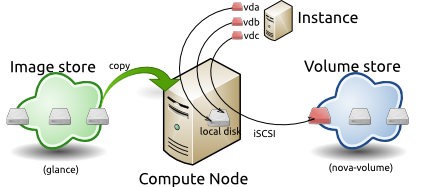This introduction provides a high level overview of what images and instances are and description of the life-cycle of a typical virtual system within the cloud. There are many ways to configure the details of an OpenStack cloud and many ways to implement a virtual system within that cloud. These configuration details as well as the specific command line utilities and API calls to preform the actions described are presented in the Image Management and Volume Management chapters.
Images are disk images which are templates for virtual machine file systems. The image service, Glance, is responsible for the storage and management of images within OpenStack.
Instances are the individual virtual machines running on physical compute nodes. The compute service, Nova, manages instances. Any number of instances maybe started from the same image. Each instance is run from a copy of the base image so runtime changes made by an instance do not change the image it is based on. Snapshots of running instances may be taken which create a new image based on the current disk state of a particular instance.
When starting an instance a set of virtual resources known as a flavor must be selected. Flavors define how many virtual CPUs an instance has and the amount of RAM and size of its ephemeral disks. OpenStack provides a number of predefined flavors which cloud administrators may edit or add to. Users must select from the set of available flavors defined on their cloud.
Additional resources such as persistent volume storage and public IP address may be added to and removed from running instances. The examples below show the cinder-volume service which provide persistent block storage as opposed to the ephemeral storage provided by the instance flavor.
Here is an example of the life cycle of a typical virtual system within an OpenStack cloud to illustrate these concepts.
The following diagram shows the system state prior to launching an instance. The image store fronted by the image service, Glance, has some number of predefined images. In the cloud there is an available compute node with available vCPU, memory and local disk resources. Plus there are a number of predefined volumes in the cinder-volume service.
To launch an instance the user selects an image, a flavor and optionally other attributes. In this case the selected flavor provides a root volume (as all flavors do) labeled vda in the diagram and additional ephemeral storage labeled vdb in the diagram. The user has also opted to map a volume from the cinder-volume store to the third virtual disk, vdc, on this instance.
The OpenStack system copies the base image from the image store to local disk which is used as the first disk of the instance (vda), having small images will result in faster start up of your instances as less data needs to be copied across the network. The system also creates a new empty disk image to present as the second disk (vdb). Be aware that the second disk is an empty disk with an emphemeral life as it is destroyed when you delete the instance. The compute node attaches to the requested cinder-volume using iSCSI and maps this to the third disk (vdc) as requested. The vCPU and memory resources are provisioned and the instance is booted from the first drive. The instance runs and changes data on the disks indicated in red in the diagram.
There are many possible variations in the details of the scenario, particularly in terms of what the backing storage is and the network protocols used to attach and move storage. One variant worth mentioning here is that the ephemeral storage used for volumes vda and vdb in this example may be backed by network storage rather than local disk. The details are left for later chapters.
Once the instance has served its purpose and is deleted all state is reclaimed, except the persistent volume. The ephemeral storage is purged. Memory and vCPU resources are released. And of course the image has remained unchanged through out.




